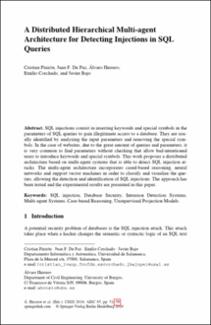Mostrar el registro sencillo del ítem
A Distributed Hierarchical Multi-agent Architecture for Detecting Injections in SQL Querie
| dc.contributor.author | Pinzón Trejos, Cristian | |
| dc.contributor.author | De Paz, Juan | |
| dc.contributor.author | Herrero, Álvaro | |
| dc.contributor.author | Corchado, Emilio | |
| dc.contributor.author | Bajo, Javier | |
| dc.date.accessioned | 2018-06-06T19:17:38Z | |
| dc.date.accessioned | 2018-06-06T19:17:38Z | |
| dc.date.available | 2018-06-06T19:17:38Z | |
| dc.date.available | 2018-06-06T19:17:38Z | |
| dc.date.issued | 2010-07-02 | |
| dc.date.issued | 2010-07-02 | |
| dc.identifier.uri | http://ridda2.utp.ac.pa/handle/123456789/4796 | |
| dc.identifier.uri | http://ridda2.utp.ac.pa/handle/123456789/4796 | |
| dc.description | SQL injections consist in inserting keywords and special symbols in the parameters of SQL queries to gain illegitimate access to a database. They are usually identified by analyzing the input parameters and removing the special symbols. In the case of websites, due to the great amount of queries and parameters, it is very common to find parameters without checking that allow bad-intentioned users to introduce keywords and special symbols. This work proposes a distributed architecture based on multi-agent systems that is able to detect SQL injection attacks. The multi-agent architecture incorporates cased-based reasoning, neural networks and support vector machines in order to classify and visualize the queries, allowing the detection and identification of SQL injections. The approach has been tested and the experimental results are presented in this paper. | en_US |
| dc.description.abstract | SQL injections consist in inserting keywords and special symbols in the parameters of SQL queries to gain illegitimate access to a database. They are usually identified by analyzing the input parameters and removing the special symbols. In the case of websites, due to the great amount of queries and parameters, it is very common to find parameters without checking that allow bad-intentioned users to introduce keywords and special symbols. This work proposes a distributed architecture based on multi-agent systems that is able to detect SQL injection attacks. The multi-agent architecture incorporates cased-based reasoning, neural networks and support vector machines in order to classify and visualize the queries, allowing the detection and identification of SQL injections. The approach has been tested and the experimental results are presented in this paper. | en_US |
| dc.format | application/pdf | |
| dc.language | eng | |
| dc.language.iso | eng | en_US |
| dc.rights | https://creativecommons.org/licenses/by-nc-sa/4.0/ | |
| dc.rights | info:eu-repo/semantics/openAccess | |
| dc.subject | SQL injection | en_US |
| dc.subject | Database Security | en_US |
| dc.subject | Intrusion Detection Systems | en_US |
| dc.subject | Multi-agent Systems | en_US |
| dc.subject | Case-based Reasoning | en_US |
| dc.subject | Unsupervised Projection Models | en_US |
| dc.subject | SQL injection | |
| dc.subject | Database Security | |
| dc.subject | Intrusion Detection Systems | |
| dc.subject | Multi-agent Systems | |
| dc.subject | Case-based Reasoning | |
| dc.subject | Unsupervised Projection Models | |
| dc.title | A Distributed Hierarchical Multi-agent Architecture for Detecting Injections in SQL Querie | en_US |
| dc.type | info:eu-repo/semantics/article | |
| dc.type | info:eu-repo/semantics/publishedVersion |
